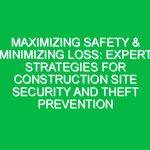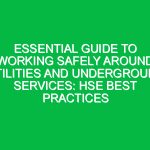Working at height remains one of the most significant hazards in the construction industry, contributing to a substantial number of accidents and fatalities each year. Managing construction work at height safely is not just a regulatory requirement but a moral obligation to ensure the well-being of workers. In the realm of Health Safety and Environment (HSE), adopting effective strategies for managing work at height is crucial. This article explores five essential strategies that can significantly mitigate risks and enhance safety for construction workers operating at elevated levels.
Understanding the Risks of Working at Height
Before delving into the strategies, it’s imperative to understand the risks associated with working at height. Falls from height can result from various factors, including unstable working platforms, failure to use personal protective equipment (PPE), and lack of training. Recognizing these risks is the first step towards mitigating them effectively.
Strategy 1: Comprehensive Planning and Risk Assessment
Importance of Planning
Effective planning is the cornerstone of managing construction work at height safely. It involves identifying tasks that require working at height and assessing the associated risks. A thorough plan should outline the procedures, equipment needed, and emergency response measures.
Conducting a Risk Assessment
A detailed risk assessment is vital in identifying potential hazards and determining the necessary control measures. It should consider factors such as the height of the work, the duration and frequency, and the condition of the working surface. The findings of the risk assessment should inform the planning process.
Strategy 2: Use of Appropriate Personal Protective Equipment (PPE)
Selecting the Right PPE
Personal Protective Equipment (PPE) plays a critical role in safeguarding workers from the risks of working at height. The selection of PPE should be based on the nature of the work and the level of risk involved. Common PPE for working at height includes safety harnesses, helmets, and fall arrest systems.
Training on PPE Usage
Merely providing PPE is not enough. Workers must be trained on the correct usage, maintenance, and inspection of PPE. Regular training sessions can ensure that workers are familiar with the equipment and can use it effectively in case of an emergency.
Strategy 3: Implementing Fall Protection Measures
Guardrails and Safety Nets
Physical barriers such as guardrails and safety nets are effective in preventing falls. These measures provide a collective level of protection, reducing the reliance on individual PPE. Installing guardrails around the perimeter of working platforms and safety nets below can significantly reduce the risk of fall-related injuries.
Personal Fall Arrest Systems
For situations where guardrails and safety nets are not feasible, personal fall arrest systems (PFAS) offer a viable solution. PFAS are designed to stop a fall before the worker hits the ground, minimizing the risk of serious injury. It’s crucial to ensure that PFAS are correctly anchored and that workers are trained in their use.
Strategy 4: Training and Competence
Importance of Training
Training is a critical component of managing work at height safely. Workers should receive comprehensive training on the risks of working at height, the use of PPE, and emergency procedures. Training should be ongoing, with regular refresher courses to keep workers up to date with the latest safety practices.
Ensuring Competence
Competence goes beyond having the necessary skills; it also involves understanding and applying safety principles in practice. Employers should ensure that workers are not only trained but also competent to carry out their tasks safely. This may involve supervising new or less experienced workers until they demonstrate sufficient competence.
Strategy 5: Regular Inspection and Maintenance
Inspecting Equipment
Regular inspection of equipment used for working at height is essential to ensure its safety and functionality. This includes checking PPE, guardrails, ladders, and scaffolding for any signs of wear or damage. Defective equipment should be repaired or replaced immediately.
Maintenance of Work Areas
Maintaining clean and organized work areas can significantly reduce the risk of accidents. This involves removing any unnecessary materials or obstacles that could cause trips or falls. Regular housekeeping can also improve the overall safety and efficiency of the work environment.
Summary of Key Points
Managing construction work at height safely requires a comprehensive approach that encompasses planning, risk assessment, the use of appropriate PPE, implementation of fall protection measures, training and competence, and regular inspection and maintenance. By adopting these five essential strategies, employers can significantly reduce the risks associated with working at height and ensure a safer work environment for their employees. Remember, safety at height is not just about compliance with regulations; it’s about safeguarding lives.


